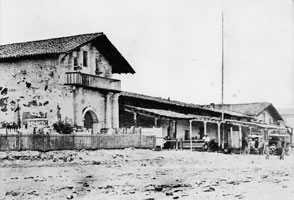







Mission San Francisco de Asis’ chapel was finished in 1791. The adobe walls are four feet thick and may have been one of the reasons that the chapel was one of the buildings that was left standing after the 1906 San Francisco earthquake and fire. The Mission has survived several earthquakes including the ‘Loma Prieta’ earthquake in 1989. The buildings have been reinforced with steel to make them stronger.

Those that lived at the Mission went by a strict schedule. The Fathers were used to this type of lifestyle, but the neophytes were not. The structure of Mission life was one of the reasons many Native Californians tried to leave. A French explorer, Jean François de La Pérouse, visited Mission San Carlos is 1786 and wrote a detailed account of what he observed. Events at the Mission were signaled by the ringing of the Mission bells. Each day started around sunrise (about 6am). The Mission bells would ring to wake everyone and summon them to Mass and morning prayers. Prayer lasted for about an hour and then everyone would go to breakfast. Atole, a type of soup made from barley and other grains, would be served. Breakfast took about 45 minutes and then it was time for everyone to go to work.
The Fathers were responsible for running the Mission and instructing the new converts and children in the Catholic faith. Most of the men went to the fields to tend to the crops or to help with the animals while women stayed at the Mission and worked on domestic chores such as weaving cloth and making clothes, boiling down fat to make soap and candles, and tending to the vegetable gardens. Children often helped at these chores around the Mission once their religious instruction was over. Depending on the particular industry at the Mission there also might be neophytes leatherworking, metalworking, wine making, and pressing olives for olive oil.
At noon the bells would ring again for everyone to gather for dinner, what we would call lunch. Lunch was normally pozole, another thick soup with beans and peas. After an afternoon break everyone returned to their work for another two to four hours depending on how much work there was to be done. A last bell would be rung to end the work day. Another serving of Atole would be served and the neophytes would be able to rest until it was time for bed (Margolin, Pg. 85). Women were usually expected to go to bed by 8pm and men by 9pm. Most of the Fathers allowed their neophytes to continue to hunt and gather additional foods and to cook some of their traditional dishes.
Living at the Mission was often difficult for new converts. They were used to working when work needed to be done and resting when they were tired. The Mission lifestyle was different. The Neophytes were the main source of labor for the Missions. It was their hard work along with the soldiers’ and Fathers’ that built the Missions and their outbuildings. Agriculture and ranching required constant tending to the crops and animals. Without this labor the Missions would not have been able to survive. Many neophytes missed the freedom of their tribal life and would try to leave the Mission. The Fathers wouldn’t allow neophytes to leave and would send soldiers to search for them and bring them back. Runaways were usually punished for breaking the rules.
Life at Mission San Francisco de Asis was cold and damp. The weather was very poor and a number of the neophytes and fathers were often sick. Even with the poor weather the Mission was able to raise cattle, sheep, mules, and horses as well as several different crops including wheat, corn, beans, barley, peas and lentils, and had a fruit tree orchard.

 The Mission suffered through secularization as most of the other Missions did. In 1850 President James Buchanan returned some of the Mission lands to the Church. The Pueblo of Yerba Buena, eventually to become the city of San Francisco, started to grow toward the Mission and eventually made the Mission part of the city’s boundaries.
The Mission suffered through secularization as most of the other Missions did. In 1850 President James Buchanan returned some of the Mission lands to the Church. The Pueblo of Yerba Buena, eventually to become the city of San Francisco, started to grow toward the Mission and eventually made the Mission part of the city’s boundaries.

- The Author’s Name: Tricia Weber
- The Title of the Page: (Look at the banner at the top of the page.)
- The Date the Page was Last Updated: August 18, 2006
- The URL(Web Address) of the Page: (Look in the Address Bar at the top of the page.)
- The Date you Visited the Page: Use today’s date.